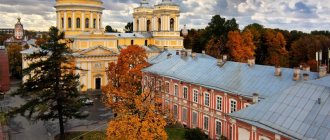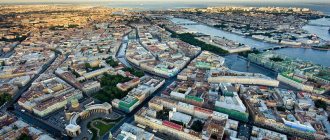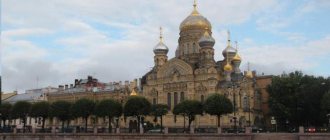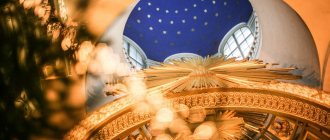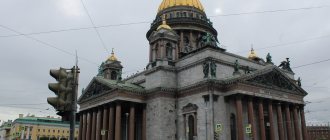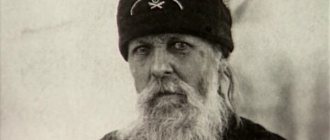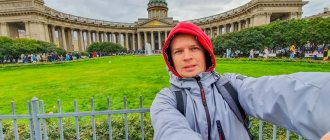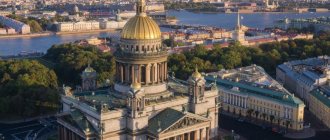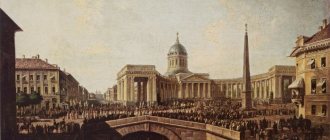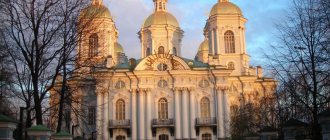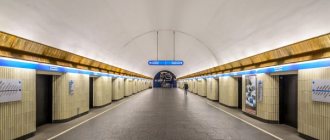In 1710, one important event occurred in the life of St. Petersburg, which cannot but be put in direct connection with the beginning of the existence of St. Petersburg as a capital. This year the foundation stone of the Alexander Nevsky Monastery took place.
Tsar Peter, examining St. Petersburg, focused his attention on the place where the Black River flows into the Neva and ordered the construction of a monastery here in the name of the Holy Trinity and St. Alexander Nevsky.
Archimandrite of the future monastery Theodosius erected a cross at the place indicated by Peter with the inscription that “a monastery will be created” here.
In 1711, the Annunciation Church was built on the site, and in 1713 the first cells appeared. From this year the monastery began its existence.
The monastery was named in memory of the man whose name was associated with the first victory on the Neva over the Swedes, one of the most revered among the people, whom the church canonized as a saint back in 1547.
It is unlikely that Peter then conceived the transfer of the relics of Alexander Nevsky to St. Petersburg. This was carried out only in 1723.
It is worth paying attention to one more fact: the monastery was very far from the central part of St. Petersburg.
Now Nevsky Prospekt is the street connecting the royal center with the Alexander Nevsky Lavra. 300 years ago, these few kilometers passed through dense forest and swamp.
This removal of the holy hierarchs from the “decision-making center” was symbolic, especially if we remember the struggle Peter had to endure in restructuring church dogmas.
St. Petersburg, Monastyrka River embankment, building 1
The Alexander Nevsky Lavra is located opposite the exit from the Alexander Nevsky Square metro station, in the building of the Moscow Hotel.
Exit the metro, cross Nevsky Prospekt across the square. The entrance to the Lavra is opposite the passage.
Mode, address, tickets
Opening hours 2021, 2021:
Territory of the Lavra - from 05:30 to 23:00
Trinity Cathedral - from 05:45 to 20:00
Museum - ancient repository:
Wednesdays and Fridays from 12:00 to 17:00
Ticket prices:
Admission is free, but donations are required to enter the museum.
Address:
St. Petersburg, Monastyrka River embankment, 1
Metro: “Alexander Nevsky Square”
Holy names
- Holy Prince Alexander Nevsky
- Bishop Innokenty (Kulchinsky)
- Bishop of Irkutsk and Nerchinsk (Kristalevsky)
- Metropolitan of Kiev and Galicia Vladimir (Epiphany)
- Metropolitan Seraphim (Chichagov)
- Archbishop Procopius (Titov)
- Bishop Victor (Ostrovidov)
- Holy Venerable Seraphim of Vyritsky
- Venerable Martyr Archimandrite Leo
- Venerable Theodore of Sanaksar
- Metropolitan Veniamin of Petrograd and Gdov
- Hieromartyr Gregory, Bishop of Schlissenburg
- Hieromartyr Innocent
- Venerable Martyr Seraphim
- Prince Fyodor of Novgorod
History of construction
In St. Petersburg, by order of Peter I, work began on the construction of the Nevsky Cathedral in 1710. On March 25, 1713, its official opening took place. Archimandrite Theodosius was in charge of the monastery and was also involved in its arrangement.
Under the leadership of the architect Trezzini, 2 years later, a plan for the Lavra complex was designed. The scientist imagined this place as a symmetrical ensemble of stone structures located between two rivers - the Neva and Monastyrka (Chernaya Rechka). However, its implementation was delayed for a long time. Photos of the original design of the Alexander Nevsky Lavra can be viewed on the map of the official website. The main work on the construction of the architectural ensemble was carried out during the reign of the monarchs Elizabeth I and Catherine II.
The cathedral, built according to the original plan, was later dismantled. Architect Starov created a new project, where he included the entire left bank of the Chernaya River in the complex, and planned to erect a square in front of the entrance.
Lavra: a cultural heritage site of St. Petersburg
In 1797, by order of Paul I, the monastery was given a new title - monastery, which later became the spiritual and cultural center of the capital. The Alexander complex was patronized by absolutely all reigning monarchs.
Under Peter I, a school was opened here, which was attended by the offspring of clergy, after which it was called a seminary, and then an academy. The monastery also operated a printing house and an almshouse.
In the 20th century, many new formations appeared on the territory of the cathedral, such as singing courses, a museum of ancient repositories, the Seraphim-Antony cell, and an infirmary. In 1920, the historical ensemble was awarded the title of a historical monument of culture and heritage.
In 1918, the St. Petersburg Monastery was abolished. But it operated unofficially until 1932. The revival of monasticism took place at the end of the 20th century. Simultaneously with the divine service, generally accepted crafts were restored: icon painting and jewelry, carpentry and the production of Orthodox miniatures from tin. A map of the location of objects and the address of the Alexander Nevsky Lavra in St. Petersburg can be viewed on the official website.
Monastery monuments
- Monument to the Holy Blessed Prince Alexander Nevsky
Located in front of the Lavra gates. The sculptor was A.G. Kozenyuk, he considered this work the most important in his life. The sketches twice won the city competition for the best design of the monument, and in 2000 they were approved. The monument was erected in 2002. According to the artist’s plan, the prince’s personality united the ideas of spirituality, valor and service to the country.
- Monument “2000 years from the Nativity of Christ”
It is a monument almost seven meters high, located at the side passage to the Lavra. Author - E.P. Solovyova.
- Monument to those who suffered for the faith of Christ
Created in 2005 and dedicated to all the new martyrs and preachers who died for Orthodoxy in the twentieth century. Its main element is the cross, the symbol of faith, and the face of Christ. They are enclosed in a circle, symbolizing salvation through the self-sacrifice of Christ and a call to get rid of confrontation and bloodshed.
- Worship Cross
The appearance of the Cross in the Lavra is timed to coincide with the renewal of friendly relations between the Moscow Patriarch and the Russian Church Abroad.
- Panel of St. Alexander Nevsky
The bronze panel combines the image of the Grand Duke, the movement of his relics and the founding of the Lavra. Mounted on the wall of the Prosphora building.
- Stone icon case with the Konevskaya Icon of the Mother of God
The monument is located in the back courtyard of the Lavra, with a small garden and gazebo nearby. It was placed on a site where construction materials were stored in Soviet times, and then a parking lot was built. The marble face of the Mother of God was made in a workshop on the territory of the Alexander Nevsky Lavra in St. Petersburg.
Building complex
Today, the Alexander Nevsky Lavra is a large ensemble in a square shape, consisting of several buildings. It is surrounded by a trapezoidal courtyard with tower-shaped structures at the corners. The complex includes the following architectural objects:
- Holy Trinity Cathedral of the Alexander Nevsky Lavra. It was built according to the design of the architect Schwertfeger during the reign of Peter I. In the 1750s it was dismantled and in 1774-1790. rebuilt according to a new plan by Ivan Starov;
- Church of St. Nicholas the Wonderworker (1868–1871). The cathedral was erected at the Zasoborny Pogost, later renamed the Nikolskoye Cemetery of the Alexander Nevsky Lavra - 1877;
- Lazarevskaya tomb (1717). Initially, the temple was built as the tomb of Princess Natalya Alekseevna;
- Spiritual Corps (1717);
- Metropolitan Corps (1756–1764);
- Feodorovskaya Church (1742–1747). From the 17th to the beginning of the 20th century, burials were held in the temple;
- Fedorovsky Corps (1725–1748);
- Annunciation Cathedral (1717);
- Seminary building (1756–1761);
- Cathedral of the Descent of the Holy Spirit (1717–1725);
- Prosphora Corps (1761–1771);
- Gate Church (1784–1786);
- Cathedral of the Mother of God (1869). The church was erected at the cemetery, which in 1876 was given the name Tikhvinskoe;
- Isidor's Cathedral (1890–1891). The name of the temple was given in honor of Metropolitan Isidore, who consecrated it;
- The library building is used as an ancient storage facility, library, archive.
- Consistory (1900).
The monastery ensemble of St. Petersburg also includes 4 churchyards:
- Lazarevsky – Necropolis of the Alexander Nevsky Lavra XVIII;
- Cossack;
- Tikhvinsky (Masters of Arts);
- Nikolsky.
The 18th century necropolis and the Tikhvin burial ground belong to the State Museum of Sculpture, founded in 1932.
Divine services
| Holy Trinity Cathedral | |||
| Brotherly prayer service | Morning service, at which all the brethren who are not engaged in obedience are present | Mon-Sat | 6.00 |
| Midnight Office | Night service dedicated to the second coming of the Lord | Mon-Sat | 6.20 |
| Early liturgy | The main service at which the sacrament of the Eucharist occurs | Sun | 7.00 |
| Late Liturgy | Sat-Sun, major holidays | 10.00 | |
| Evening service | Occurs at nine o'clock in the afternoon, towards sunset | daily | 17.00 |
| Akathist to the Sweetest Jesus | Sun | 15.00 | |
| Akathist to the Mother of God before the icon “Neva Quick to Hear” | Sat | 14.00, 15.00 | |
| Akathist to the Holy Blessed Grand Duke Alexander Nevsky | Mon-Wed, Fri | 14.00 | |
| Akathist to St. Nicholas the Wonderworker | Thu | 14.00 | |
| Church of the Holy Blessed Prince Fyodor of Novgorod | |||
| Late Liturgy | Mon-Fri | 10.00 | |
| Evening service | Occurs at nine o'clock in the afternoon, towards sunset | Sun-Thu | 17.00 |
| Gate Church in honor of the Icon of the Mother of God “Joy of All Who Sorrow” | |||
| Early liturgy | The main service at which the sacrament of the Eucharist occurs | Mon-Sat | 7.00 |
Modern activities of the Lavra
Today, the Alexander Nevsky Lavra is a working and developing monastery for men. Divine services are held here daily. These include the liturgy, evening and morning services, confession, prayer service, akathist, passion and midnight service. The schedule, opening hours and schedule of services of the Alexander Nevsky Lavra are on the official website.
In 1999, a Christian pilgrimage destination was created in the monastery complex. Here trips are organized to the holy places of St. Petersburg, Russia and the Near Abroad for the purpose of worship and familiarization with the spiritual heritage of church life. Tours are conducted by residents of the monastery and experienced Orthodox guides. The opening hours of the Alexander Nevsky Lavra of St. Petersburg are indicated on the official website.
In 2013, a youth club was organized at the monastery. Its goal is to unite young parishioners, to enable them to acquire true values, spiritual faith and support in life.
The cathedral also hosts the sacraments of weddings and baptisms, and there are also Church Slavonic language courses and a Sunday school. Numerous religious events are held on the territory of the complex: national holidays and celebrations dedicated to the spiritual and cultural development of society. On the official website of the Alexander Nevsky Lavra of St. Petersburg you can find the schedule and time of events, as well as all the necessary information.
Fairs and exhibitions
- Trinity Orthodox Fair
It takes place at the end of May, timed to coincide with the Holy Trinity Day. There you can buy food, meat, honey from Russian farmers, buy candles, church literature and utensils, serve a prayer service for loved ones and light candles.
- Honey Spas
Exhibition-fair of honey, where guests can taste honey from beekeepers, monasteries, farmsteads, purchase fresh vegetables and fruits, church utensils and souvenirs, serve prayers and light candles. The program includes Cossack festivities and cuisine.
- Orthodox fair
Takes place in mid-autumn in the Metropolitan Garden. During the fair, you can purchase honey: taiga, Krasnodar, Pskov and others, meat, fish products, vegetables, sweets, baked goods, delicacies from monastic farms and Russian farmers, clothes made from natural fabrics. Parishioners can submit requests and notes about relatives and friends.
Cost of tickets to the necropolises of the Alexander Nevsky Lavra - summer 2021
- Visit to the 18th century Necropolis and
the Necropolis of Art Masters For Russian citizens, adult ticket - 300 rubles - children of preschool age - free
- Russian schoolchildren and students - 100 rubles
- pensioners of Russia and Belarus - 100 rubles
- adult ticket - 400 rubles
Necropolis of masters of art)
- For Russian citizens, an adult ticket is 150 rubles
- adult ticket - 200 rubles
History of the Alexander Nevsky Lavra in St. Petersburg
It is believed that on July 15, 1240, at the place where the Black River (now Monastyrka) flows into the Neva, a battle between the squad of Prince Alexander Nevsky and the Swedes took place. In memory of those events, as well as in honor of the victory over the Swedes in 1704, Peter I decided to build a monastery here and gave it the name - Holy Trinity Alexander Nevsky Monastery. Prince Alexander Nevsky was canonized by the church for his good deeds for the Fatherland. The people called the monastery Alexander's Temple.
The monastery was founded in 1710 according to the design of Domenico Trezzini and I. Starov. In 1712, the first buildings appeared next to the monastery. A wooden Annunciation Church and chapel were built. In 1713 the church was consecrated. The monastery settlement is being built up.
According to the project, the monastery complex included churches, cells (monks’ living rooms), the metropolitan’s chambers and other buildings. The buildings were built in a “rest” - the letter P with churches in the corners. A garden with a flower bed was laid out on the territory of the monastery.
The main building of the monastery is located near the Monastyrka river. I. Starov also completed the design of the Church of the Mother of God of All Who Sorrow Joy - the Gate Church, which was so named because of its location above the gates of the monastery.
One of the first buildings of the monastery is the Church of the Annunciation, located on the right bank of the Monastyrka (architects D. Trezzini and T. Schwertfeger, 1724). The church building has survived to this day. It was built on the site of the wooden Annunciation Church. The church has a rectangular plan and is decorated with pilasters. Topped with an octagonal dome on a high drum. It was here that the relics of St. Alexander Nevsky were originally transferred. Here are the ashes of Anna Leopoldovna, Alexei Razumovsky, Alexander Suvorov.
In the mid-18th century, several more buildings were built, including the Metropolitan House, the Seminary, and the Prosphora buildings (architect M. D. Rastorguev). I. Starov also designed a round square in front of the entrance to the monastery territory.
In 1720, a printing house was opened at the monastery. Later, the monastery housed a seminary, which was transformed into the Theological Academy, which still operates today. By decree of Paul the First in 1797, the monastery acquired the highest status - the status of a monastery.
Architectural features
The ensemble of the Lavra of Alexander Nevsky in St. Petersburg is distinguished by its clarity of composition, clarity of lines; the monumentality of the Trinity Cathedral is contrasted with the graceful towers and Lavra buildings. A large role in the perception of the composition is played by greenery, flower beds and trees surrounding buildings.
The central building is Trinity Cathedral. It was founded under Peter the Great. The Cathedral is distinguished by its grandiose dimensions - the height to the cross is 30 m. The porch is built from the west and is surrounded by columns, and two angels watch over those entering the Cathedral. On a fine day, the large gilded dome of the Cathedral literally burns in the sun.
The true treasure is the relics of St. Alexander Nevsky, resting in a silver shrine donated to the monastery by Empress Elizabeth Petrovna. It bears inscriptions and images telling about the life of the prince.
The prosphora case is representative of the Baroque era. It is distinguished by an elegant composition and complex design solutions, and radiating galleries emphasize its length. Throughout its history, the building has undergone virtually no changes, which is its value.
The seminary building was erected in accordance with the existing buildings from Peter's time. From the main volume of the building there are galleries with large windows, the space between which is decorated with pilasters designed to support the cornice.
The two-story outbuilding with a portico, built in the Russian Baroque style, plays a significant role in the perception of the entire building. Both buildings are similar in appearance and interiors and create a unified picture.
The Metropolitan building stands out for its rich architectural design. Columns and pilasters, complex cornices, and elegant window frames give the building a solemn appearance. Among the interiors, the decoration of the reception hall has been preserved, which demonstrates the features of the ceremonial premises of the 18th century.
In 1910, the monastery library was moved to a specially erected building in the late eclectic style. The architectural design of the library building is distinguished by a mixture of various styles from neo-Renaissance to Byzantine style.
The building looks somewhat heavy and stands out from the general solemn, light style of the complex, but at the same time it is a valuable example of the architecture of St. Petersburg of the 19th century.
Necropolis of the Alexander Nevsky Lavra
On the territory of the monastery in 1716, the Lazarevskoe cemetery was founded, where the Church of St. Lazarus was built. V. Sheremetev, F. Uvarov, D.I. are buried in the Lazarevsky necropolis. Fonvizin, M.V. Lomonosov, D. Kvarneghi, A.N. Voronikhin. HELL. Zakharov, J.F. Thomas de Thomon, C. Rossi, A.V., M.I. Kozlovsky. N.M. rests at the Novo-Lazarevskoye cemetery. Karamzin, I.A. Krylov, V.A. Zhukovsky, F.M. Dostoevsky, M.I. Glinka, M.P. Mussorgsky, N.A. Rimsky-Korsakov, P.I. Tchaikovsky, A.A. Ivanov, B.M. Kustodiev, V.I. Demut-Malinovsky, B.I. Orlovsky, P.K. Klodt, V.F. Komissarzhevskaya, N.K. Cherkasov and other famous figures.
Later, the Tikhvin Cemetery (1823) joined the Alexander Nevsky Lavra. Both cemeteries are combined into the Necropolis. Then, in 1861, the Nikolskoye cemetery also became part of the Necropolis. After the reconstruction of Nevskaya Embankment in the 1960s, the Nikolskoye cemetery was significantly reduced in size. The historian L.N. was buried here. Gumilyov and the first mayor of the city A.A. Sobchak. Nikolskoye Cemetery is currently the only active burial site at the Alexander Nevsky Lavra.
In 2002, an equestrian monument to Prince Alexander Nevsky (sculptor V. G. Kozenyuk) was unveiled on the square in front of the monastery. The main holiday of the cathedral is September 12 - the day of the transfer of the relics of St. Alexander Nevsky.
The Alexander Nevsky Lavra is one of the most beautiful architectural ensembles of St. Petersburg. Tourists come to look at the beauty and severity of the monastery buildings and bow their heads before the outstanding figures of Russia who rest here. The Alexander Nevsky Lavra has not lost its spiritual role, despite all the persecutions of Soviet times, and functions as a monastery today.
Nikolskoye Cemetery
Seleznev S.P., commander of the Leningrad Military District, and his wife were buried at the cemetery in 1996. Both died in a plane crash. Their grave is located next to the church.
In 1998, G.V. Starovoitova, a deputy of the State Duma, who was killed in the entrance of her house, was buried near the temple.
In 2000, the first mayor of St. Petersburg, A. A. Sobchak, found eternal peace.
In 2008, F. G. Uglov, a famous surgeon, was buried here.
On the left side of the main alley is the grave of L. N. Gumilyov, a historian and son of the famous poets A. A. Akhmatova and N. S. Gumilyov. Modest Korf, a lyceum friend of A. S. Pushkin, artist M. O. Mikeshin, architect V. A. Quesnel and many other prominent people also rest here. This cemetery is not as clean and well-kept as Tikhvinskoye. The ancient tombstones were lopsided here and there.
